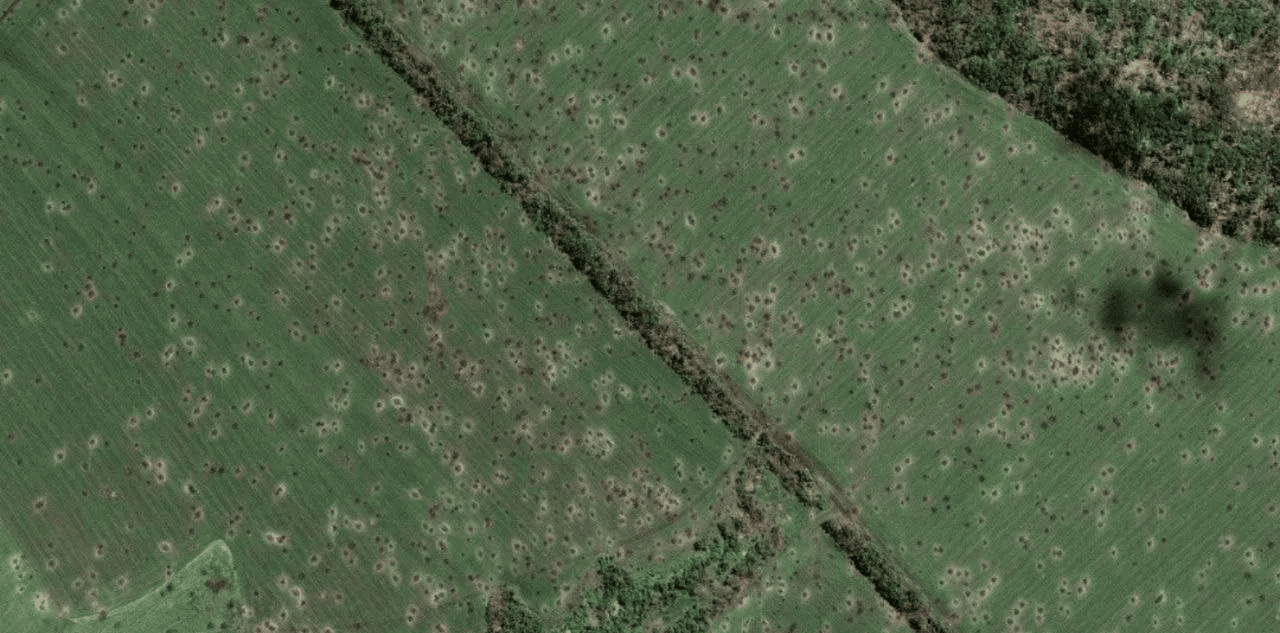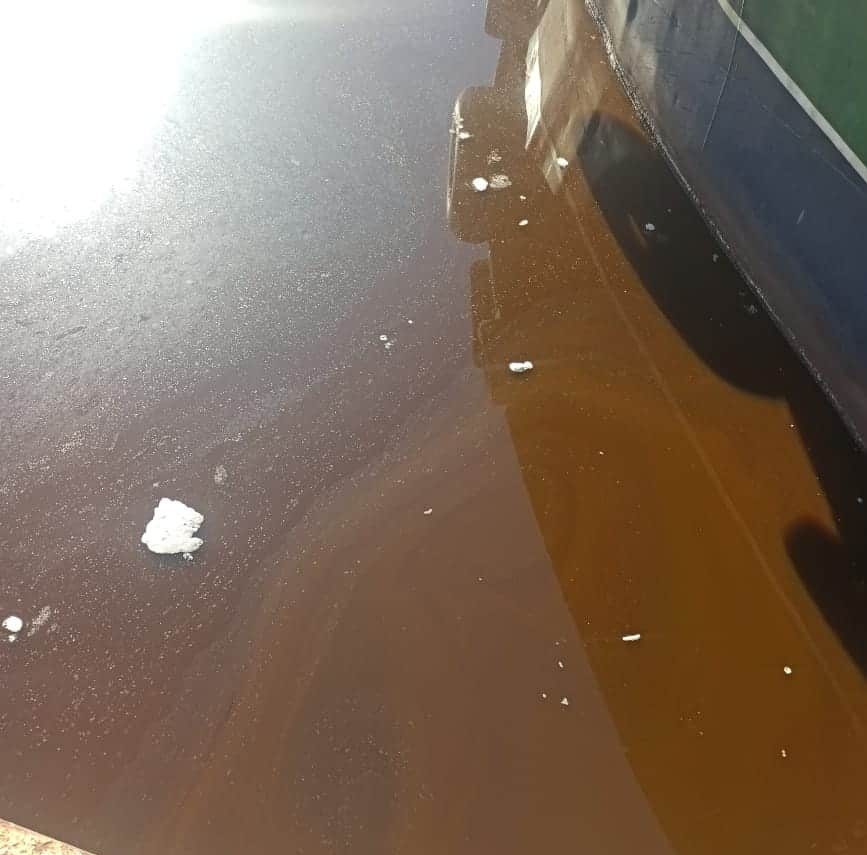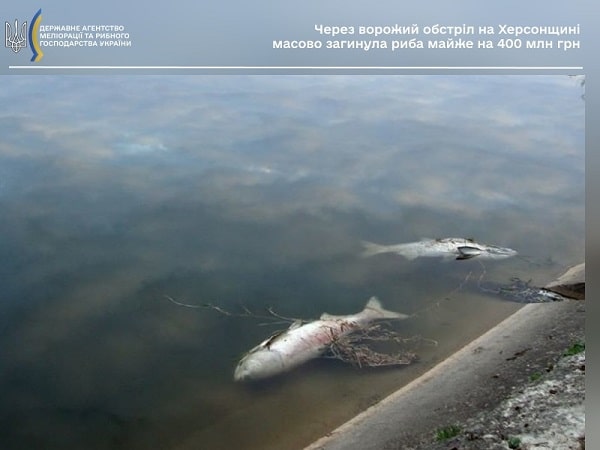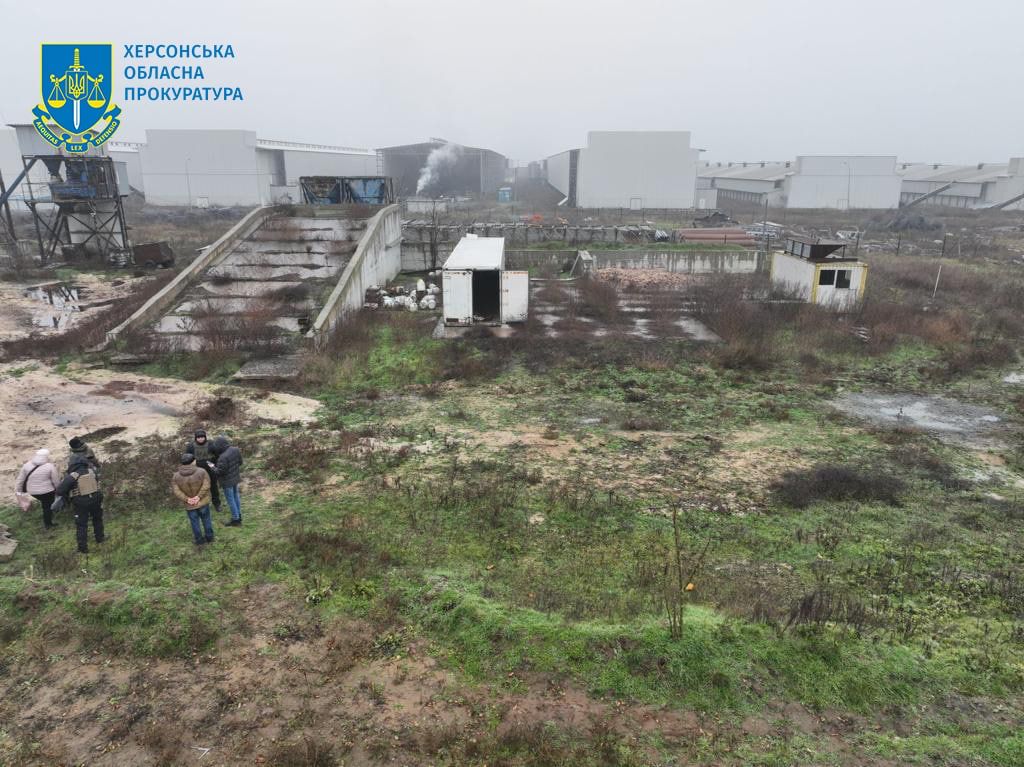Table of Contents
- Soils suffer the most from military actions
- The water situation in the occupation zone is uncontrollable
- Environmental disasters provoked by Russian military in the Kherson region
- The occupation of part of Ukraine threatens the world’s food security
- Grain production in the Kherson region decreased by 37 percent
- An approximate estimate of the environmental damage caused by the war to Ukraine
- Post-war actions
According to the Ministry of Ecology, the full-scale war of the Russian Federation against Ukraine, which began on February 24, 2022, has already caused unprecedented damage to the Ukrainian environment. Russians are seeking to destroy not only the Ukrainian nation but also our nature. The hostilities on the territory of Ukraine affect the air quality, pollute the soil and water reservoirs, and destroy crops. This poses a threat to the nation’s health and will cause enormous damage to the ecosystem of the entire Eastern Europe in the long run. First and foremost, the environment of the Black Sea countries, which are in close proximity to Ukraine, will be affected.
Soils suffer the most from military actions
Fertile soils are one of the greatest natural resources of Ukraine and the world, as one-third of the world’s black soil (сhernozem) is Ukrainian. As a result of the hostilities, the upper, most fertile layers of soil suffer the most. They are also the slowest to recover: the natural rate of fertile soil recovery is one centimeter per hundred years. It takes nature 10,000 years to form chernozem. It would take a moment for a missile to explode there to destroy it. Scientists say that the damage to agriculture will be enormous, and even more so to the environment.
These facts are recorded by the Operational Headquarters of the State environmental inspectorate of Ukraine, which employs more than 70 scientists from around the world. They monitor the environmental damage caused by the war, and civil society organizations join them.
Since the beginning of the war, Russian troops have been shelling oil depots and large industrial facilities across Ukraine. Heavy metals from shells and military equipment are getting into the soil and groundwater. Fires in the forests and steppes are destroying the habitat of rare species.
“Soil will be contaminated by the war for longer than we will live. This is a matter of several generations. There are several main factors of damage to the land: the passage of heavy military equipment, the explosion of missiles and other weapons, and the construction of fortifications. As a result of these actions, the structure of the soil is disturbed, and this leads to erosion. The loss of fertility is obvious because the fertile layer of soil is at the very surface,” says Oleksii Vasyliuk, head of the Ukrainian Nature Conservation Group.
According to him, soil is a huge ecosystem. It can function only when all living organisms be there. One handful of soil can contain 8,000 small organisms. Living organisms cannot survive in the epicenter of a munition explosion.
Environmentalists say it’s not just physical damage to the soil. Another problem is its chemical damage. The explosion of each munition is a chemical reaction. 100% of the chemical part of the shell gets into the environment: some into the air, some directly into the soil. Soils, groundwater and underground water are contaminated with large amounts of toxic metals and other chemical compounds. Aluminum, copper, and other heavy metals will end up in the soil. Oxidation of explosives releases sulfur and nitrogen into the air and soil. Sulfur is considered to be the most dangerous for soils, as it turns into sulfuric acid in contact with precipitation. This is bad, in particular, for soils because millions of organisms that form the topsoil are burned in this acid.
According to the Ukrainian Nature Conservation Group, there are areas where experts have estimated approximately 2,052 craters from various projectiles in just one square kilometer of the field, which in terms of pollution for the soil means 50 tons of iron, a ton of sulfur compounds and almost 2.5 tons of copper. The explosions pulled out 90 thousand tons of soil. This gives us an idea of the likely extent of the damage the war is causing to Ukrainian soil – although it is impossible to fully assess the full extent of the land contamination.
This is also confirmed by Anastasia Splodytel, a landscape geochemist who has been studying the contamination of soils in Donbas affected by the war since 2016. She claims that more than 1,000 soil samples taken in the combat areas showed the highest content of heavy metals, exceeding background values by 15-30 times. And due to the migration of heavy metals from the soil to groundwater, the environment outside the war zone is also being polluted.
The State environmental inspectorate states that as of February 18, 2023, 14 million square meters of land in Ukraine are contaminated with the remains of destroyed facilities and ammunition, and more than 280,000 square meters of soil are contaminated with hazardous substances. Soil is also damaged by the passage of heavy machinery and the construction of fortifications.
Russians use phosphorus bombs prohibited by international conventions – the products of burning phosphorus and their solutions form salts in the soil. An excess of phosphates is very harmful to flora and fauna.
“Another problem is the bodies of dead Russian soldiers, which have not been taken from Ukrainian lands for a long time. And this problem is already taking on an ecological nature because corpse poison gets into groundwater, and dead bodies are eaten by animals,” said military expert Oleg Zhdanov.
The areas that have been directly affected by military aggression account for about 35% of Ukraine’s territory, where there is already a systemic disturbance of the surface’s soil layer or a risk of contamination.
“The area of contamination of Ukrainian soil is millions of hectares. Currently, there is no assessment of the state of all territories,” says Taras Vysotskyi, the First Deputy Minister of Agrarian Policy and Food of Ukraine, about the possible scale of contamination.
The water situation in the occupation zone is uncontrollable
Water is a valuable resource for both humans and the environment. As a result of the hostilities and the man-made pollution caused by them, the destruction of bridges, dams and coastlines, and the poisoning of oil products and heavy metals, many rivers and ponds in Ukraine have suffered pathological impacts on biodiversity.
Russian troops are shelling water infrastructure, mining dams, and conducting military operations in the Black and Azov Seas. The Russian army is destroying sewage pumping stations. As a result of these actions, reclaimed water flows into the Dnipro River without any treatment. In the first months of the war, Russian military shelled oil depots in Kharkiv, Chernihiv, Luhansk, Zhytomyr, Kalynivka, Lviv, Dubno, Lutsk, and Kherson. Such explosions lead to pollution of both soil and water resources.
The Bug estuary is polluted with sunflower oil due to Russian drone attacks in the Mykolaiv region (south of Ukraine)
An additional problem is the Russian illegal withdrawal of Dnipro water from the Kakhovka Reservoir and its supply to Crimea in violation of technological requirements. The first thing Russians did in the first days of the war was to seize the main structure of the North Crimean Canal, the Kakhovka Hydroelectric Power Plant and all the hydraulic structures that regulated the water supply from the Kakhovka Reservoir to the Crimean Peninsula.
On February 27, 2022, they destroyed the temporary dam, the road bridge, and the main partition structure of the canal and let water flow to the Crimean Peninsula without preparing the canal for this. Estimates by the State environmental inspectorate indicate that Russian soldiers steal more than UAH 32 million worth of water per day.
Since the beginning of 2023, specialists of the State environmental inspectorate of Ukraine have recorded a decrease in the water level in the basin of the Kakhovka Reservoir in the Kherson region and mass fish kills in the lower reaches of the Dnipro River. The water has moved away from the banks by an average of 7-15 meters, causing the reservoirs in Vasylivska, Kairskaya and other reserves on the territory of the currently occupied Kakhovka district to become shallow.
“Due to damage to the locks of the Kakhovka Hydroelectric Power Plant, a gradual decrease in the water level in the Kakhovka Reservoir has been observed over the last 2 months. The water level in the reservoir’s bowl has dropped from 0.4 to 1.4 to 1.6 meters (according to various expert assessments and analysis of citizens’ photos),” said Maksym Soroka, an environmental safety expert.
He assumed that the loss of the reservoir’s balance water reserves reaches 10%. This forces us to consider the worst-case scenarios.
Experts note that the Kakhovka Reservoir is currently at its lowest water level in all the years of its existence, which causes a number of other problems in cities and villages in the Dnipropetrovsk, Kherson and Zaporizhzhia regions. In particular, it negatively affects the supply of drinking water to Berdiansk, Prymorsk and more than 20 other settlements in the southern part of the region, and creates problems with irrigation of agricultural land in the Kherson region, which will affect crop yields.
“So there are huge risks there. Since this is a zone of active hostilities and a conditional military border between the Ukrainian Armed Forces and the territory occupied by Russia, there is no access to repair these facilities. And most likely, until we liberate the Kherson coast, there will be no such access. Accordingly, these losses will increase,” said Mykhailo Yatsiuk, director of the Institute of Water Problems and Land Reclamation of the National Academy of Agrarian Sciences of Ukraine.
The situation at the Kakhovka Reservoir is currently uncontrollable, with no possibility to use water resources for irrigation and drinking water supply. And losses in general may lead to restrictions or termination of irrigation of agricultural land in the south of Ukraine, which threatens crop failure, losses for agricultural enterprises and bankruptcy for small farms.
Environmental disasters provoked by Russian military in the Kherson region
Again, it is currently impossible to assess the environmental damage caused to the Kherson region, as only 30 percent of the region’s territory has been liberated. This is the right-bank Kherson region, but most of it is under constant shelling by Russian troops using various types of weapons.
However, today we can already name a number of environmental problems provoked by Russian soldiers in the Kherson region. The main environmental consequences of the occupation of the Kherson region:
– the destruction of the Kherson poultry farm in Chornobaivka;
– fires on the Kinburn Peninsula;
– environmental disaster of the Azov and Black Seas;
– chaotic water discharge at the Kakhovka Hydroelectric Power Plant and the possibility of its explosion;
– oil leakage into the Dnipro River;
– lowering of the water level in the Kakhovka Reservoir and massive fish kills.
On March 2, Russian shelling cut off the power supply to a large poultry farm near Kherson, causing the automatic bird feeding system to shut down. As a result, 4 million chickens died at the poultry farm. They were buried to protect groundwater and soil from contamination. The burial pits are deep enough that the soil can act as a filter for methane that can be released by decomposing birds. But, despite this, such a situation can have negative environmental consequences for the territory, especially for the soil and groundwater.
The death of such a large number of poultry without the possibility of utilization is an extraordinary event, an environmental disaster. This issue has become so critical that it was raised separately at a meeting of the UN General Assembly.
Prosecutors of the Kherson Regional Prosecutor’s Office are currently providing procedural guidance in the criminal proceedings over the mass destruction of wildlife that could cause an environmental disaster.
The occupation of part of Ukraine threatens the world’s food security
The criminal actions of the Russian Federation in polluting soil and surface water threaten crop failures, losses and bankruptcy for agricultural enterprises, and exacerbate the global food crisis. This could have catastrophic consequences for the whole world and human health since Ukraine is one of the main players in agriculture and food production.
Historically, Ukraine has been a major grain exporter. In 2021, the country fed 400 million people worldwide. Until 2022, it exported an average of 50 million tons of agricultural products annually.
In addition, in 2020-2021, Ukraine exported 5.27 million tons of sunflower oil for sale, which accounted for 46.9% of global exports.
Approximately 90% of wheat and grain from Ukrainian fields was transported to world markets by sea. After the full-scale invasion, Russia blocked the Black Sea coast, so during the first 5 months of the war, grain exports via the main sea routes were forced to stop.
It is also worth noting the negative impact on the agricultural sector from the damage to agricultural land. According to FAO’s (Food and Agriculture Organization) estimates, during the period of Russia’s full-scale war against Ukraine, 33% of Ukrainian agricultural land has already suffered significant degradation, which will have a corresponding impact on agricultural production. According to a study by experts, about 25% of the rural population engaged in agricultural activities has stopped or reduced production due to the war.
According to the Kyiv School of Economics in its Agricultural War Damages Review, 50% of the damage in the agricultural sector is caused to agricultural land (mine contamination or direct physical contamination) and unharvested crops.
“And since agricultural products can be grown on the soil and groundwater can be used as a source of drinking water, all these elements can enter the food chain. And if they get into the human body, it can lead to significant health problems in the future,” explains Yevhenia Zasiadko the head of the climate department at Ecoaction (Center for Environmental Initiatives).
Grain production in the Kherson region decreased by 37 percent
The 2023 sowing season in the liberated Kherson region is under threat: fields are mined and equipment is damaged. In some places, the need for sappers to inspect agricultural land reaches 95 percent of the community’s land. This was stated by Yuriy Sobolevsky, First Deputy Chairman of the Kherson Regional Council, at a briefing at the Ukraine-Uninform Media Center.
He emphasized that not all of the liberated territory has been checked for mines and unexploded ammunition, which is a very high risk for people working on the land. In addition, Russian military looted everything they could – they took away agricultural machinery and production lines for processing agricultural products. The material and technical base has been almost destroyed. He added that it will take time and support from the state to restore it.
“According to the results of 2022, grain production in the Kherson region decreased by 37% compared to the previous record figures of 2021 and amounted to about 53.9 million tons. All these negative trends are a consequence of Russia’s war in Ukraine,” said Yuriy Sobolevsky.
This is also reported by residents of the region. In the liberated territory of the right bank, it would seem that it would be possible to start agricultural work. However, the land is mostly contaminated with metal or mines, or there is unexploded ammunition. Unfortunately, there are cases of deaths of people who went to work in the field.
“We have a community on the front line, 7 kilometers to the left bank, near Russian troops. Accordingly, sowing on the coastal strip will be impossible at all,” says Andriy Seletsky, head of the Novovorontsovka village military administration.
The situation is similar in Bilozerka, Beryslav, Velyko Oleksandrivka and Vysokopilla territorial communities.
“We are an agricultural community. Our economy in the community was based on the agricultural sector. Now it is impossible to cultivate this land because it is also now full of explosive objects. That is why we are working to clear the fields of mines as soon as possible so that farmers can go out into the fields. This means jobs, the economy, and harvests because everyone felt that the Kherson region did not produce a harvest this year,” says Hanna Shostak-Kuchmyak, the head of the Vysokopillia community.
In the occupied territory of the left bank of the Kherson region, it is impossible to track the situation. However, in conversations with heads of agricultural enterprises and farms, it turned out that some of them managed to sow winter crops. However, no one can say for sure whether they will have to harvest them.
It is the front line and the territory of the left bank of the Dnipro River which is under fire, and where Russian troops in the occupied part of the Kherson region are looting the property of agricultural enterprises – they took away tractors, combines, and machines. They carry out grain nationalization, “inspections” and demand re-registration under Russian legislation, and those who do not comply are threatened with confiscation of property. There are cases when Russian military farmers sign a contract under which up to 70% of the future harvest will belong to Russian troops. Disobedient farmers are sent for interrogation and taken to the basement. Such facts take place in almost every settlement of the left-bank Kherson region.
Given this situation, most managers of agricultural enterprises and farms left for government-controlled territory, while some suspended their operations. Some tried to work despite the pressure.
“I left, but my son stayed on the farm, and he is trying to do something to save the harvest,” said Stepan, director of a farm in the left-bank Kherson region. “We sowed winter crops in the hope that our territory will be liberated. There is a lot of uncultivated land. Now there are no opportunities to work there fully: there is a lack of spare parts, seeds, fertilizers, and plant protection products, and it is almost impossible to sell the harvest. They took almost all the agricultural machinery, opened the warehouses and took the grain. They searched the house several times, demanded that we register the farm under Russian law and pay them “taxes,” and threatened us. But we still feel responsible to our landlords – we have to pay for our shares.”
Oleksandr Musienko, head of the Chulakivka village military administration of the Skadovsk district, spoke about the situation in the agricultural sector in the occupied part of the Kherson region.
“Adelaide enterprise had about 4 thousand hectares of land leased from shareholders. In 2022, during the fall field work, they sowed only 300 hectares of land with wheat, just in case. All the rest of the land is uncultivated and there are no plans to cultivate it, at least until the territory is liberated. As for the rest, it will be cultivated in about this percentage,” Musienko said.
The lost income of agricultural producers is more than five times higher than the amount of physical damage caused by the Russian army. Compared to the direct losses, which currently amount to $6.6 billion, the indirect losses of the agricultural sector from the war were estimated by the Kyiv School of Economics and the Ministry of Agrarian Policy at a much higher amount – direct losses and indirect losses in agriculture totaled more than $40 billion.
While in recent years, about 9 million hectares of winter crops have been sown, only 4.4 million hectares are planned for the 2023 harvest. The spring crops sowing campaign is approaching, and if farmers do not find reasons to be optimistic, we can expect a significant reduction in production next year. Currently, we cannot use about 25% of the area due to the ongoing hostilities or temporary occupation of the territories.
But despite all the challenges, the agricultural sector continues to operate. Many farmers continue to sow, harvest, fertilize and work. For more than a year now, they have been doing their best to ensure food security for Ukraine and the world.
An approximate estimate of the environmental damage caused by the war to Ukraine
In total, during the year of the war, Russian aggression has caused damage to Ukraine’s environment in the amount of more than UAH 1 trillion 896 billion, the State environmental inspectorate reported. Of course, the above amount is approximate, since, given the hostilities, an accurate calculation is currently impossible.
In particular, the decline in crop production caused losses of $14.2 billion. The decline in livestock production resulted in $348.7 million in losses. This includes a reduction in live weight production, as well as an annual decline in milk, eggs, and bee products, with an expected decline of 10%.
According to the State environmental inspectorate, from February 24, 2022, to January 24, 2023, the full-scale invasion recorded a quantitative indicator of the damage caused by Russian troops: 280,904 m² of soil contaminated with hazardous substances; 12,277,512 m² of land contaminated with the remains of destroyed facilities and ammunition; 686,816 tons of petroleum products were burned during the shelling, polluting the air with dangerous substances; 1,597 tons – the mass of pollutants that entered water bodies; 2,903,513 kg – the mass of foreign objects, materials, waste and/or other substances that got into water bodies; 410,150,000,000 m³ – volume of water collected/used arbitrarily.
Post-war actions
The post-war restoration of the occupied territory of Ukraine and the part that was in the zone of active hostilities is impossible without the participation of specialized specialists, including botanists, professors, and environmentalists. The work must be comprehensive and will be carried out only after the territories have been cleared of debris and explosive devices.
“It is necessary to invite scientists who will conduct research on the territory. They have to examine everything. We should understand what was growing in each mutilated area. It will also be necessary to draw up a recovery plan for tens of years because not everything is as fast as we would like,” says Ivan Moysienko, a board member of the Ukrainian Nature Conservation Group.
For example, if Russian troops dug a trench in the steppes during their stay or there are holes left by rockets or shells, the territory should be leveled and reclaimed. After the area is reclaimed, it must be given time to overgrow. And then plants are sown anew. This also takes time.
“I emphasize that this is not only a long but also a difficult and expensive process of recovery,” adds Ivan Moyisienko.
Experts from the Ecoaction: Center for Environmental Initiatives say that after the war is over, in addition to documenting all environmental damage (to make Russia pay for it), it is also important to include restoration and protection of ecosystems in Ukraine’s recovery plan, as well as rebuilding settlements with a focus on natural solutions to combat and adapt to climate change.
The Ministry of Environmental Protection and other organizations are trying to record as many crimes committed by the Russian army against the environment as possible to have evidence in courts and receive proportionate reparations from Russia. Every Ukrainian can help in this endeavor. The Ministry has created an official resource and a mobile application called EcoZagroza (Threat), where users can become part of an “eco-battalion” and help identify and record all environmental crimes committed by Russian military in Ukraine.
Originally posted on Gromada Group. Translated and edited by the UaPosition – Ukrainian news and analytics website
See also: Decades and billions of dollars. When will Ukrainian fields and cities be cleared of Russian mines?




